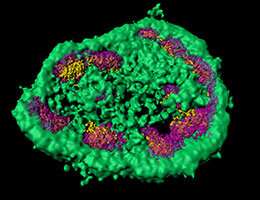New function for the nucleolus

The nucleolus is a well-known structure in the cell nucleus that is easily visible under a light microscope. This nuclear structure is known to be the site of ribosome production. A new study shows that the nucleolus is also a site of quality control for proteins.
When cells are stressed, proteins tend to misfold and to aggregate. To prevent proteins from clumping, some are temporarily stored in the nucleolus. The special biophysical conditions found in this organelle help to prevent harmful protein aggregation, as Ralf Jungmann, a professor of Experimental Physics at LMU and Leader of the Molecular Imaging and Bionanotechnology Group at the Max Planck Institute (MPI) for Biochemistry, in cooperation with F.-Ulrich Hartl and Mark Hipp (both based at the MPI for Biochemistry) now demonstrate in a new study that appears in the journal Science.
The nucleolus is a structure found in the cell nucleus, which was first described in the 1830s. In the 1960s it was recognized that ribosomes, the cell's protein factories, are assembled in this organelle. Researchers have known for some time that proteins known as chaperones move into the nucleolus under certain circumstances. It has been suggested that this relocation is related to protein production. However, the new work shows that the chaperones that migrate to the nucleolus are already bound to stress-sensitive proteins.
As a pioneer of chaperone research, F.-Ulrich Hartl and his team previously discovered that chaperones are crucial for the correct folding of proteins, and play a central role in protein quality control. If proteins fail to fold correctly, their misfolded forms can accumulate and clump together. The resulting protein aggregates can often be observed in neurodegenerative diseases, such as Alzheimer's, Parkinson's or Huntington's disease.
Mark Hipp, corresponding author of the study and a member of F.-Ulrich Hartl's department, comments: "We have been using the enzyme luciferase as a model protein for many years in order to investigate the mechanisms of protein folding." By fusing the enzyme to a fluorescent protein, the scientists can track it under the microscope, and observe whether the protein is correctly folded or is misfolded and forms aggregates. "We were able to show that stressing cells by heating them to 43°C results in the transport of the misfolded luciferase protein, together with the chaperones, into the nucleolus."
To elucidate the mechanistic details of this process, the researchers cooperated with the groups led by Ralf Jungmann, who has developed a number of high-resolution fluorescence techniques, and Jürgen Cox (also at the MPI for Biochemistry), who contributed novel bioinformatic analysis methods. Together they were able to show that the misfolded luciferase protein behaved differently within the nucleolus than in the rest of the cell. "In the nucleolus, misfolded proteins were kept in a liquid-like state instead of aggregating," explains Frédéric Frottin, first author of the study. This is possible due to the specific biophysical conditions that prevail within the organelle.
"Proteins that usually tend to aggregate are stored in a less dangerous form during stress, which protects cells from damage. Once the cell has had time to recover, the proteins can be refolded and released from the nucleolus," continues Frottin. At this point, the cells have the capacity to activate further mechanisms that enable the protein to be repaired or degraded. The researchers also demonstrated that this protective mechanism fails if the cell stress lasts too long. "This is a new mechanism that maintains the integrity of the cell," says Mark Hipp. Maintaining this integrity is ultimately essential to inhibit the development of disease and retard the aging process.
More information: F. Frottin et al. The nucleolus functions as a phase-separated protein quality control compartment, Science (2019). DOI: 10.1126/science.aaw9157
Journal information: Science
Provided by Ludwig Maximilian University of Munich




















